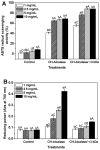Anti-Oxidative and Anti-Aging Activities of Porcine By-Product Collagen Hydrolysates Produced by Commercial Proteases: Effect of Hydrolysis and Ultrafiltration
- PMID: 30897764
- PMCID: PMC6472052
- DOI: 10.3390/molecules24061104
Anti-Oxidative and Anti-Aging Activities of Porcine By-Product Collagen Hydrolysates Produced by Commercial Proteases: Effect of Hydrolysis and Ultrafiltration
Abstract
To investigate methods for improving the processing of porcine waste, porcine skin was hydrolyzed using different commercially available proteases (Alcalase, Flavorzyme, Neutrase, Bromeline, Protamex, and Papain) under several optimal conditions. Following enzymatic hydrolysis, the collagen hydrolysates (CHs) were fractionated by molecular weight (3 kDa) via membrane ultrafiltration. The CHs were analyzed for physical properties (pH, protein recovery, free amino group content, molecular weight distribution, and amino composition) as well as for functional properties (antioxidant activities and anti-aging activities). Among the CHs, CHs hydrolyzed by Alcalase (CH-Alcalase) exhibited the highest degree of hydrolysis compared to other CHs. Both "CH-Alcalase" and "CH-Alcalase < 3 kDa" fractions showed a considerably high antioxidant activity and collagenase inhibition activity. Therefore, resulting bioactives have potential for development as antioxidants and anti-aging ingredients in the food, cosmetics, and pharmaceuticals, from animal by-products.
Keywords: anti-aging; antioxidant; collagen hydrolysate; commercial proteases; hydrolysis.
Conflict of interest statement
The authors declare no conflict of interest.
Figures





Similar articles
-
Effect of neutrase, alcalase, and papain hydrolysis of whey protein concentrates on iron uptake by Caco-2 cells.J Agric Food Chem. 2010 Apr 28;58(8):4894-900. doi: 10.1021/jf100055y. J Agric Food Chem. 2010. PMID: 20230001
-
Anti-Salmonella Activity and Peptidomic Profiling of Peptide Fractions Produced from Sturgeon Fish Skin Collagen (Huso huso) Using Commercial Enzymes.Nutrients. 2021 Jul 30;13(8):2657. doi: 10.3390/nu13082657. Nutrients. 2021. PMID: 34444819 Free PMC article.
-
Antioxidant activities of hydrolysates of Arca subcrenata prepared with three proteases.Mar Drugs. 2008;6(4):607-19. doi: 10.3390/md6040607. Epub 2008 Nov 20. Mar Drugs. 2008. PMID: 19172198 Free PMC article.
-
Use of Alcalase in the production of bioactive peptides: A review.Int J Biol Macromol. 2020 Dec 15;165(Pt B):2143-2196. doi: 10.1016/j.ijbiomac.2020.10.060. Epub 2020 Oct 20. Int J Biol Macromol. 2020. PMID: 33091472 Review.
-
Collagen Hydrolysates: A Source of Bioactive Peptides Derived from Food Sources for the Treatment of Osteoarthritis.Medicines (Basel). 2023 Sep 1;10(9):50. doi: 10.3390/medicines10090050. Medicines (Basel). 2023. PMID: 37755240 Free PMC article. Review.
Cited by
-
Mimicking the Hierarchical Organization of Natural Collagen: Toward the Development of Ideal Scaffolding Material for Tissue Regeneration.Front Bioeng Biotechnol. 2021 Apr 27;9:644595. doi: 10.3389/fbioe.2021.644595. eCollection 2021. Front Bioeng Biotechnol. 2021. PMID: 33987173 Free PMC article. Review.
-
Antihypertensive and Antioxidant Activity of Chia Protein Techno-Functional Extensive Hydrolysates.Foods. 2021 Sep 28;10(10):2297. doi: 10.3390/foods10102297. Foods. 2021. PMID: 34681347 Free PMC article.
-
Local and Systemic Peptide Therapies for Soft Tissue Regeneration: A Narrative Review.Yale J Biol Med. 2024 Sep 30;97(3):399-413. doi: 10.59249/TKNM3388. eCollection 2024 Sep. Yale J Biol Med. 2024. PMID: 39351323 Free PMC article. Review.
-
From microbes to molecules: a review of microbial-driven antioxidant peptide generation.World J Microbiol Biotechnol. 2023 Dec 7;40(1):29. doi: 10.1007/s11274-023-03826-7. World J Microbiol Biotechnol. 2023. PMID: 38057638 Review.
-
Optimization of Hydrolysis Conditions, Isolation, and Identification of Biologically Active Peptides Derived from Acheta domesticus for Antioxidant and Collagenase Inhibition.Antioxidants (Basel). 2024 Mar 18;13(3):367. doi: 10.3390/antiox13030367. Antioxidants (Basel). 2024. PMID: 38539901 Free PMC article.
References
-
- Je J.-Y., Qian Z.-J., Byun H.-G., Kim S.-K. Purification and characterization of an antioxidant peptide obtained from tuna backbone protein by enzymatic hydrolysis. Process Biochem. 2007;42:840–846. doi: 10.1016/j.procbio.2007.02.006. - DOI
-
- Agyei D., Ongkudon C.M., Wei C.Y., Chan A.S., Danquah M.K. Bioprocess challenges to the isolation and purification of bioactive peptides. Chem. Eng. Res. Des. 2016;98:244–256. doi: 10.1016/j.fbp.2016.02.003. - DOI
MeSH terms
Substances
LinkOut - more resources
Full Text Sources

